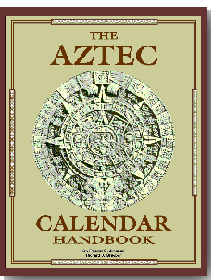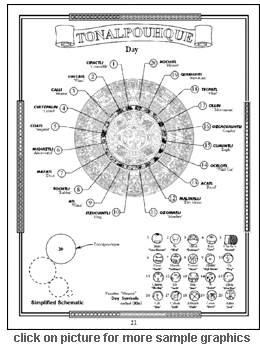New Book bridges Ancient Wisdom with Modern
Technology!

 The
ancient wisdom ascribed is found behind the creation of a 500-year-old artifact, the Aztec
Calendar. To the Natives it was Teoilhuicatl Apaluaztli Ollin Tonal Machiotl meaning
the Great and Venerable Mechanism of the Universe. In contrast,
the modern technology was used to create a Technical Manual for the Aztec Calendar that
delineates the elements of this ancient monument with engineering documentation
techniques. [Note: The Aztec
name was given to the Mechican Indians (ch as in chevron; sometimes
spelled Mexican) by an English writer in the 19th century.] The
ancient wisdom ascribed is found behind the creation of a 500-year-old artifact, the Aztec
Calendar. To the Natives it was Teoilhuicatl Apaluaztli Ollin Tonal Machiotl meaning
the Great and Venerable Mechanism of the Universe. In contrast,
the modern technology was used to create a Technical Manual for the Aztec Calendar that
delineates the elements of this ancient monument with engineering documentation
techniques. [Note: The Aztec
name was given to the Mechican Indians (ch as in chevron; sometimes
spelled Mexican) by an English writer in the 19th century.]
The Aztec
Calendar Handbook, involving thousands of man-hours of effort to create, takes the
Technical Manual approach to a Historical Reference book. Illustrated with over 150
technical drawings showing enlargement details, cut-away views, and computer-generated
art, this new guidebook has been called the "ultimate" Aztec Calendar reference
treatise. Distilled from over 240 sources and quoting direct eyewitnesses from the
1500’s, it further includes a glossary of over 230 native words. This attractive book
is made with parchment paper and has a leather-grained cover, making it resemble an
ancient manuscript.
 The research for writing the Aztec
Calendar Handbook was assisted by custom software to convert Native date designators
into our modern calendar dating system. In this way, a researcher is able to convert and
track the dates of events from surviving native history books, known as codices. Mountains
of information could be processed more efficiently and accurately when correlating
indigenous dates. Inversely, a Julian date can also be converted into the Mayan
long-count system. It is then possible for the Mechican calendar-labeling scheme to
be transposed over the count to generate a person’s Aztec tonallo or spiritual
name from their birth date. The research for writing the Aztec
Calendar Handbook was assisted by custom software to convert Native date designators
into our modern calendar dating system. In this way, a researcher is able to convert and
track the dates of events from surviving native history books, known as codices. Mountains
of information could be processed more efficiently and accurately when correlating
indigenous dates. Inversely, a Julian date can also be converted into the Mayan
long-count system. It is then possible for the Mechican calendar-labeling scheme to
be transposed over the count to generate a person’s Aztec tonallo or spiritual
name from their birth date.
According to
Native tradition, our current long-count cycle will be complete in December 2012. A
long-count cycle, credited to the Olmec/Maya, is 5125 years and started in the year
3114BC. No one is really sure what will happen when the cycle ends, or at least they
aren’t talking.
By looking at
myths, legends & history with an Aztec’s perception of God, this new Manual
provides needed answers to some important questions.
Would you like
to know about how and when the Maya influenced the design of the Aztec Calendar?
Have you ever seen the Hopi version of the Quetzalcoatl? Would you like to put the
last 12,000 years into perspective? If so, then your library needs the Aztec Calendar
Handbook. You will find yourself referring to it over and over again. No stone was
left unturned.

REVIEWS:
"This new book is not only the Ultimate Guide
to the Aztec Calendar, it is the only guide that goes into this degree of depth
and scope of what the Mexican culture is all about."
Gerald Rodriguez, Education Director
Mexican Heritage Corporation
"This is truly a monumental effort to
reduce a vast and complicated history into a simple, clear
explanation. …an authoritative introduction
to the Aztec Calendar. It is appropriate for children and adults."
Jeff Paul, Director
Chicano Studies Library & Multicultural Center, SJSU
"This is a study that anyone who claims
any Native American ancestry must look at. The presentation is
outstanding."
Dr. Cecil Orozco, Historian, Author, Educator
University of California, Fresno
"Intriguing! This book is definitely on the right
path. I like the way you have presented the evidence and allow the reader to form
their own opinion."
Sonny Reyna, Elder and Counselor
San Juan Bautista American Indian Council
"For it's seemingly small size, your
book contains more information on this Native American artifact
than a dozen other books covering the same subject."
Professor Sam Rios, Ethnic Studies/Anthropolgy
Sacramento State University, CA
|